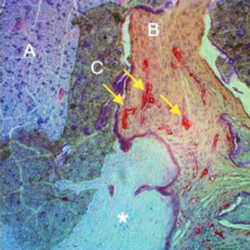3D Plotted Biphasic Bone Scaffolds for Growth Factor Delivery: Biological Characterization In Vitro and In Vivo.
Bioprinting enables the integration of biological components into scaffolds during fabrication that has the advantage of high loading efficiency and better control of release and/or spatial positioning. In this study, a biphasic scaffold fabricated by extrusion-based 3D multichannel plotting of a calcium phosphate cement (CPC) paste and an alginate/gellan gum (AlgGG) hydrogel paste laden with the angiogenic factor VEGF (vascular endothelial growth factor) is investigated with regard to biological response in vitro and in vivo. Rat mesenchymal stromal cells are able to adhere and grow on both CPC and AlgGG strands, and differentiate toward osteoblasts. A sustained VEGF release is observed, which is able to stimulate endothelial cell proliferation as well as angiogenesis in vitro that indicates maintenance of its biological activity. After implantation into a segmental bone defect in the femur diaphysis of rats, a clear reduction of the defect size by newly formed bone tissue occurs from the distal and proximal ends of the host bone within 12 weeks. The CPC component shows excellent osteoconductivity whereas the local VEGF release from the AlgGG hydrogel gives rise to an enhanced vascularization of the defect region. This work contributes to the development of novel therapeutic concepts for improved bone regeneration which are based on 3D bioprinting.

- Adv Healthc Mater. 2019 Apr;8(7)
- 2019
- Medical Biology
- 30838778
- PubMed
Enabled by:
